___________________ X f_ p_ 5 2 .05 4 10 .25 3 16 .40 2 8 .20 1 4 .10
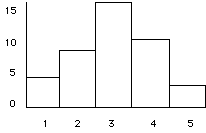
So we'll start this chapter by talking about probabilities. Then we'll move onto a discussion of normal distributions. And finally, we'll integrate the two topics.
We deal with probabilities everyday.
In a situation where several different outcomes are possible, we define the probability for any particular outcome as a fraction or proportion. If the possible outcomes are identified as A, B, C, D, and so on, then:
Probability of A = number of outcomes classified as A total number of possible outcomes
- making it more concrete:
prob of K-spades = ____picking the King of Spades ___ total number of possible cards picked= 1 / 52
Notation of probability: p(King-spades) = f / N
Notice that we've already seen this f / N formula before. Does anybody remember it?
However, for this definition of probability to be accurate, the selection of individuals (sampling) must be obtained by random sampling
A random sample must satisfy two requirements:
so let's reconsider our card game situation
Okay, let's return to frequency distributions and how they relate to probability.
Consider the following distribution.
___________________ X f_ p_ 5 2 .05 4 10 .25 3 16 .40 2 8 .20 1 4 .10 |

|
You can see that our proportion column corresponds to probability. Which in turn correspond to the area under the curve for those intervals.
p (3) = f / N = 16 / 40 = .40
What is the probability of selecting (sampling) a 5?
What about more complex questions?
What is the probability of selecting a token with a value greater than 2?
p(X > 2) = ? |

|
What is the probability of selecting a token with a value less than 5?
p(X < 5) = ? .10 + .20 + .40 + .25 = .95 |

|
What is the probability of selecting a token with a value greater than 1 & less than 4?
p(4 > X > 1) = ? .20 + .40 = .60 |

|
Y =
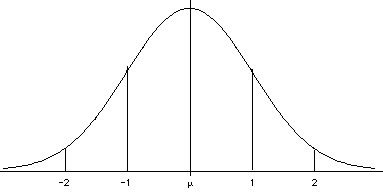
A few things to note about Normal Distributions.
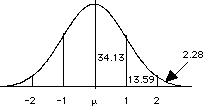
An important tool that we'll use is the unit normal table. You'll find it in the appendix of your book (pg. A24-A26). In this table are a bunch of z-scores and proportions for the Standard Normal Distribution (which is the z-score standarized Normal distribution; N(0,1)). In other words this table allows you to figure out the area under the curve (and thus the probability of sampling) at nearly every position on the curve (defined in z-scores).
Using the unit normal table.
| (A) z ____ 0.00 0.01 : : 0.30 0.31 : 1.00 : |
(B) Proportion in Body 0.5000 0.5040 : : 0.6179 0.6217 : 0.8413 : |
(C) Proportion in Tail 0.5000 0.4960 : : 0.3821 0.3783 : 0.1587 : |
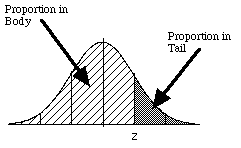 |
Notice that z = 1.0 = .5000 + .3413 = the median + the 34.13% that we mentioned before So by using the table, we can an ask about different areas under the curve. And similar to last chapter, we can go in both directions. That is, from the table of z-scores to probabilities and/or from probabilities to z-scores.
Examples:
| What is the probability of having an IQ of 130 or above? p(X > 130)?
z = (130 - 100)/15 = 2.0 --look at the table--> need Column C p = 0.0228 |
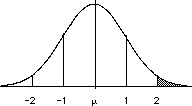 |
| What is the probability of having an IQ of 85 or less? p(X < 70)?
z = (70 - 100)/15 = -1.0 --look at the table--> need Column C p = 0.1587 |
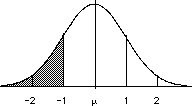 |
Here is the "best" way to find a Z-score from a probability:
| What IQ score do you need to have to be in the top 5% of the population?
The upper-tail is needed. |
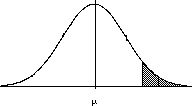 |
Sometimes we need to find the probability that X will fall between two scores rather than simply above a score or below a score.
| What is the prob. of scoring between 300 and 650 on the SAT?
recall: m = 500, s =100
p(z < (650 - 500) = p(z < 1.5) = 0.9332
100
p(z < (300 - 500) = p(z < -2.0) = 0.0228
100
the .9332 from 650 includes the lower tail, so we determine the proportion in the lower tail, and subtract that p(300 < z < 650) = .9332 - .0228 =.9104 |
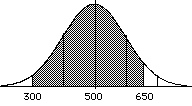 |
And finally, you might want to know what percentage lies outside two points (essentially the opposite of the last situation).
| What is the prob. of scoring lower than 300 or higher than 650 on the SAT? recall: m = 500, s =100
p(z > (650 - 500) = p(z > 1.5) = 0.0668
100
p(z < (300 - 500) = p(z < -2.0) = 0.0228
100
the two numbers both reflect the proportions in the tails, so we just need to add them together
p(300 < z < 650) = .0668 + .0228 =.0896 |
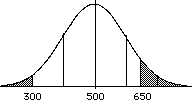 |
Another thing that you can use the unit normal table for is to find percentile ranks and interquartile ranges
Examples:
| What is your percentile rank if you have an IQ of 130?
for IQ scores m = 100, s =15 |
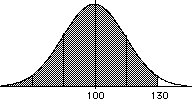 |
| What is the interquartile range for the SAT?
recall: m = 500, s =100 |
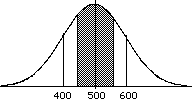 |
Note there is a short-cut for figuring out the IQR. Since the range is always + .67s, then you can compute the IQR as being (2)(.67)(m)
Let's talk about another very common distribution, the binomial distribution. This is a distribution that results when there are only two possible outcomes for a particular situation. For example, flip an unbiased coin: heads or tails, answer a yes/no question, a person either survives or dies, etc. The binomial distribution is denoted as: B(n,p), and it has a compex equation too (which you also don't need to learn).
As it turns out the normal distribution is a good approximation of the binomial distribution, if the n is big enough. We'll get back to this in a bit.
Let's think of the binomial distribution in probability terms.
n = the number of individuals (or observations) in the sample
X = the number of times a category A event occurs in the sample
Using this notation, the binomial distribution shows the probability associated with each value of X from X = 0 to X = n.
Example 1
So the probability of winning is .000001
The probability of losing is .999999
now let's start figuring out how many tickets to buy.
| 1 10 100 1,000 10,000 100,000 1,000,000 |
0.000001 0.00001 0.0001 0.0009950 0.00995017 0.09516263 0.63212074 |
Notice that even if you spend $1,000,000 to buy 1,000,000 tickets, your chances of winning are still only about 63%.
| p = p(A) = 1/2 | q = p(B) = 1/2 |
suppose that n = 2 (that is, we flip the coin twice), how many possible outcomes are there B(2, 0.5)? four
toss 1 toss 2 # of heads heads heads 2 heads tails 1 tails heads 1 tails tails 0 |
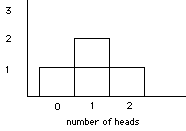 |
so what is the probability of flipping two heads? 1/4 what is the probability of flipping no heads? 1/4 what is the probability of flipping only 1 head? 2/4 what is the probability of flipping at least 1 head? 3/4
Okay, now let's suppose the n = 6. Now how many possible outcomes are there? 64 the secret formula is: 2n
t1 t2 t3 t4 t5 t6 #heads head head head head head head 6 head head head head head tail 5 head head head head tail head 5 head head head head tail tail 4 : : : : : : : tail tail tail tail tail tail 0
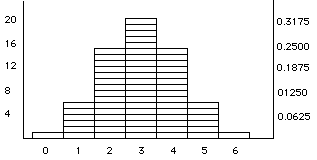
Recall, that I mentioned that the binomial distribution, when n is high, the normal distribution is a good approximation for the binomial distribution. Look how close it is with an n = 6 (pn = .5*6 = 3).
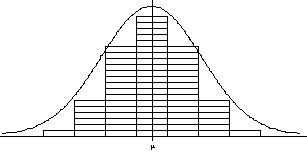
So when n = large (pn > 10) and (qn > 10), we can approximate the binomial distribution with the normal distribution.
| Mean: m = pn | Standard deviation: s =  |
z =
We can use the z-scores from the unit normal table. However, it is important to remember that the value of X on a Normal distribution is really an interval, not a point, so we need to consider the real limits when approximating the binomial distribution. That is, we are using a continuous distribution (Normal) to estimate values in a discrete distribution (the binomial distribution).
example: Sometimes a student is admitted to college who cannot or will not make it through college. If the probability of dropping out for any one persone is 0.10, then what is the probability of having more than 15 students in a class of 100 drop out?
n = 100 p = 0.10 q = 0.90 np = .10*100 = 10 nq = 90mx = pn = 10 sx =
= sqroot (100*.10*.90) = sqroot (9) = 3
p(X > lower real limit of 15) = P(X > 14.5)
= P(Z > 14.5-10) 3.0
= P(z > 1.5)
= 0.0668
example (from book) :
suppose that you take a multiple-choice test, with 4 possible answers. You didn't study so you essentially close your eyes and guess. What is the probability that you'll get 14 questions right?
| p = P(correct) = 1/4 | q = P(wrong) = 3/4 |
| pn = (1*48)/4 = 12 | qn = (3*48)/4 = 36 |
notice that both pn and qn are greater than 10
so we can assume that the distribution will be approximately normally distributed. Also, remember that the score 14 really corresponds to the interval from 13.5 to 14.5.
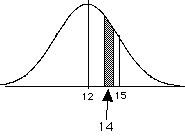 |
m = pn = 12
s = sqroot (pqn) = sqr(48*.25*.75) = sqroot (9) = 3
from table X - m = 13.5 - 12.0 = 0.50 --> 0.3085 s 3 X - m = 14.5 - 12.0 = 0.83 --> 0.2033 s 3 so the area between the two z-scores is: 0.3085 - 0.2033 = 0.1052 |